Top 34 DevOps Monitoring Tools For 2025
Nazneen Ahmad
Posted On: March 3, 2025
![]() 262570 Views
262570 Views
![]() 39 Min Read
39 Min Read
DevOps is the combination of culture, practice, and tools that integrates software development (Dev) and IT operations (Ops) to increase the speed of software applications and services release. .
When we compare it with the traditional software development approach, the operation and development team work in silos. This has caused issues like delays, errors, and miscommunications in the software development process. DevOps is the best approach that breaks down these silos and promotes communication and collaboration between the teams throughout the entire Software Development Life Cycle.
In this blog on top DevOps monitoring tools, we will learn more about the top DevOps monitoring tools to ensure optimal performance and delivery of your applications.
TABLE OF CONTENTS
- What is DevOps Monitoring?
- Top 34 DevOps Monitoring Tools
- Sensu
- Jenkins
- PagerDuty
- Liquibase
- Tasktop Integration Hub
- Middleware
- Librato
- Prometheus
- Kibana
- Splunk
- Nagios
- Akamai mPulse
- AppDynamics
- BMC Helix Operations Management
- New Relic One
- Sumo Logic
- Dynatrace
- Grafana
- Zabbix
- Datadog
- InfluxDB
- ChaosSearch
- Elastic Stack
- Elasticsearch
- Icinga
- OpenNMS
- Epsagon
- StatsD
- Collectd
- Sematext
- Honeycomb
- Monit
- BigPanda
- How to Choose the Best DevOps Monitoring Tools?
- Frequently Asked Questions (FAQs)
What is DevOps Monitoring?
DevOps monitoring is the process of monitoring software applications’ performance and functionality. Such monitoring varies from strategy to development, integration to testing, and deployment to operations. With DevOps monitoring, you can track a comprehensive and real-time view of software applications, services, and infrastructure status.
In simple terms, DevOps monitoring refers to the continuous operation of identifying, tracking, analyzing, and reporting particular components of a software development pipeline. This pipeline includes continuous planning, development, integration, testing, deployment, and operations.
With DevOps monitoring, you can increase the development team’s efficiency as it eases the finding of potential issues before releasing code to production.
The above-mentioned significance of DevOps monitoring can be leveraged by using DevOps monitoring tools. This helps to ensure the organization follows best practices throughout the DevOps life cycle in developing software applications. Now let us explore more DevOps monitoring tools.
Top 33 DevOps Monitoring Tools
Let’s look at some of the top DevOps monitoring tools for your help.
1. Sensu
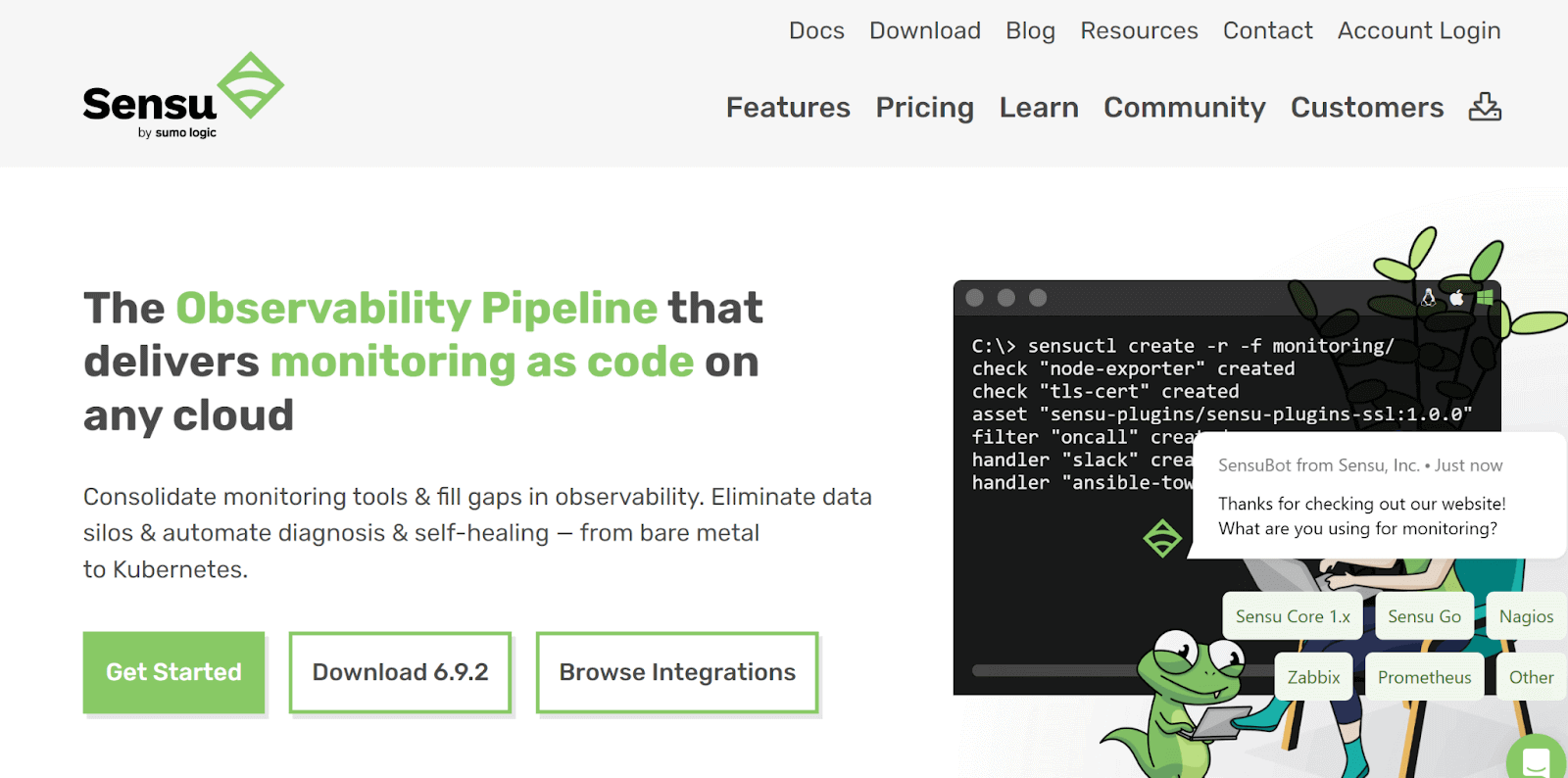
Sensu is particularly used for monitoring application solutions and infrastructure. It is one of the top cloud-based DevOps monitoring tools categorized under server monitoring tools. With Sensu, you can measure and monitor the functionality and performance of software applications, business KPIs, and infrastructure.
What makes Sensu stand out as one of the top DevOps monitoring tools?
- It is an open-source monitoring framework written in the Ruby programming language.
- It has a dedicated API and is structured to monitor large-scale dynamic systems by marking thresholds for many metrics.
- It provides an amazing view of all cloud systems and protocols, including Kubernetes.
- You can have detailed and complete system and service health monitoring using custom scripts and Nagios-style plugins.
- Offer auto-remediation capabilities, which means it can automatically set off service restarts to run the custom script when any bugs or errors are detected.
- Comprises many integrations, including incident management tools, web and automation platforms, data tools, and cloud platforms.
- It sends alerts and notifications when errors are found in your application or infrastructure.
- Provide dynamic registration and de-registration of clients. This allows clients to register with the monitoring system automatically, and present clients can also be removed.
- Sensu can be used to monitor complex environments with no issue with downtime.
- It suits for automating processes where you can configure it to automatically restart a service when it goes down and trigger a backup process when particular conditions are met.
2. Jenkins
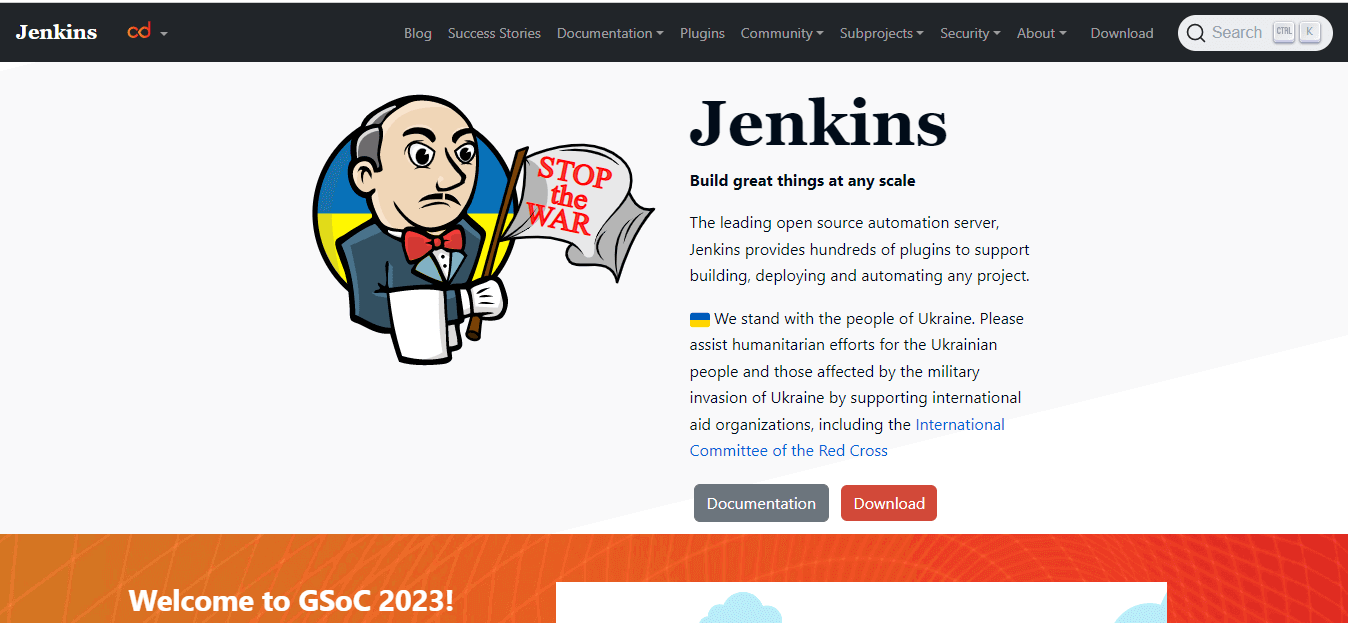
Jenkins is an open-source automation testing server, continuous integration, and DevOps monitoring tool. Jenkin is used to build, test and deploy software applications. It provides a platform for developers and DevOps teams to automate and monitor the performance of software applications.
What makes Jenkins stand out as one of the top DevOps monitoring tools?
- It is a highly popular tool among the DevOps team to implement continuous integration and delivery pipeline.
- Jenkins is an open-source tool that is free to use and can be customized to meet the needs of specific DevOps workflows.
- Supports a wide range of plugins that integrate with other DevOps tools and services. Such plugins automate tasks like source code management which allows for building a complete DevOps automation pipeline.
- It is extensible and helps developers add custom functionality to the platform using plugins and writing scripts.
- Supports CI/CD pipeline monitoring that helps the DevOps team track deployment progress in real time.
- It integrates with LambdaTest, and with this plugin, you can automate Selenium scripts from the Jenkin CI instance to LambdaTest.
Run Selenium automated tests across 5000+ real browsers & OS combinations . Try LambdaTest Now!
3. PagerDuty

PagerDuty is a cloud-based operation performance platform and DevOps monitoring tool that allows close working with operation staff to assess the reliability of the software application. In other words, PagerDuty provides a single system to the IT operations and DevOps teams for effective management of alerting, on-call scheduling, and incident management.
What makes PagerDuty stand out as one of the top DevOps monitoring tools?
- Offers an easy-to-use incident response and alerting system.
- The intuitive alerting API of PagerDuty allows you to set up and manage alerting rules for software applications and services.
- When you get an alert in PagerDuty, the system will escalate the alert automatically if it is not acknowledged or resolved within a given set of times.
- It has a powerful GUI tool for setting up on-call schedules and escalation policies. With this, you can easily manage on-call rotation and ensure that developers are notified when the incident occurs.
4. Liquibase
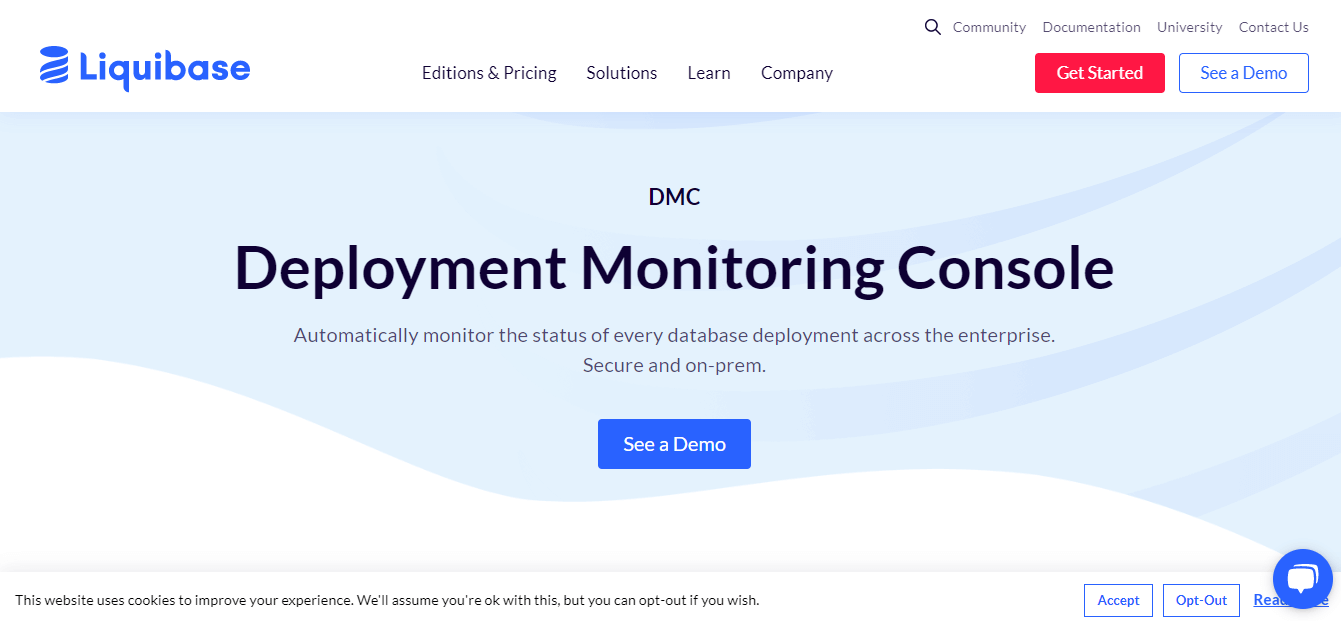
Liquibase serves as a software solution that seeks to aid in tracking each database’s deployment status within an enterprise environment. Such an environment includes multiple departments, business units, and applications, all of which must work together to achieve the organization’s goals.
The essential purpose of this DevOps monitoring tool lies in automating the monitoring of SQL script execution events throughout the entire deployment environment. This automation effort minimizes human errors and simplifies database auditing and deployment monitoring.
What makes Liquibase stand out as one of the top DevOps monitoring tools?
- One of this solution’s primary functions is its ability to simplify database auditing.
- The software, through its automation feature, effortlessly tracks deployments and errors, consequently facilitating the identification and resolution of issues as they arise.
- The Liquibase solution allows on-demand deployment information, allowing users and administrators to access information related to specific deployments promptly.
- Another impressive feature of the Liquibase is its capacity to streamline the release process. This automation software streamlines the deployment process, allowing users and administrators to track, audit, and resolve any deployment-specific database issues that may arise.
5. Tasktop Integration Hub
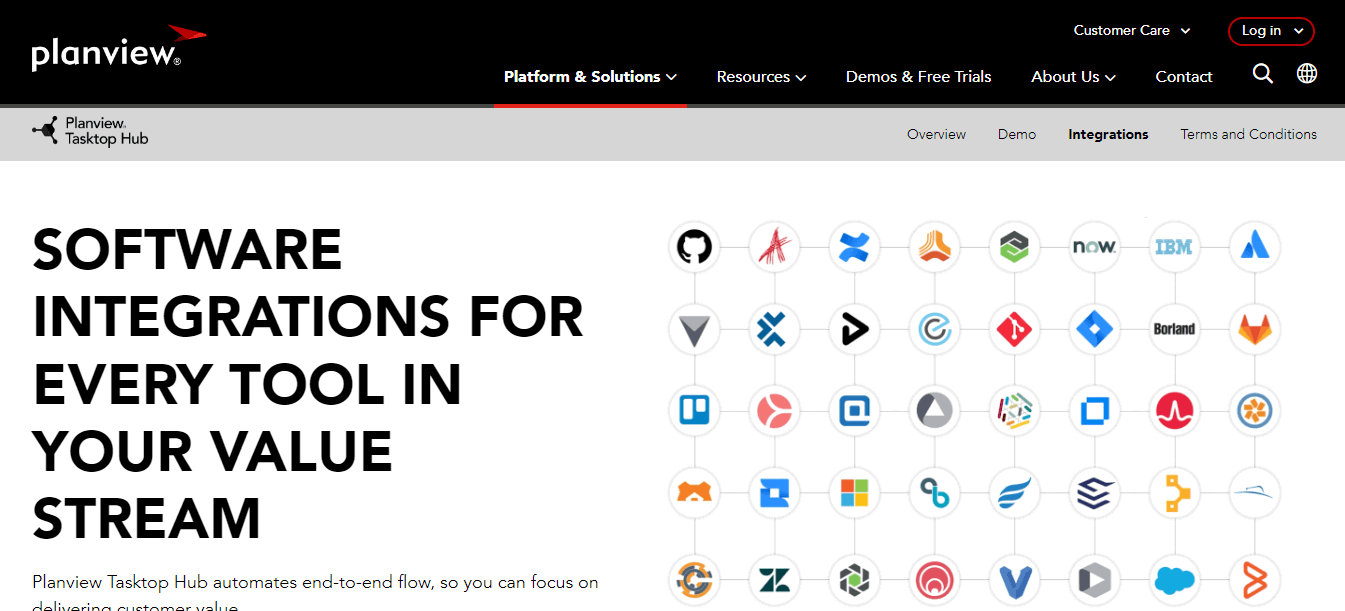
Tasktop Integration Hub is one of the DevOps monitoring tools that incorporates many software development tools and processes into the organization. Examples of such tools include issue trackers, agile planning tools, source code repositories, build systems, and test automation frameworks. It is a one-stop solution that manages all software delivery integration needs excluding the requirement of another tool.
In simple terms, you can deliver accurate information to the developers at the right time and use the right tool and interface. This tool allows the development team to associate and collaborate effectively. Thus, it improves productivity by automating workflow and information between various tools and systems.
What makes Tasktop Integration Hub stand out as one of the top DevOps monitoring tools?
- Supports integration with 45 various tools, which are completely functional with no requirement for additional configuration and setup.
- To the existing integration, Tasktop Integration Hub can also add new tools.
- It allows you to route artifacts and field updates on the ground of filters, aligning with end-user requirements related to frequency and direction.
- You can securely login through the web-based interface, which ensures that only authorized users can access the sensitive data.
- It runs with low footprints and lowers the load on other tools in the software development process. This helps ensure that integration works smoothly without slowing other processes.
- Provides real-time visibility on the software development life cycle because it automates the flow of information and allows you to monitor the progress and find any data-driven decisions.
- Provides end-to-end testing from requirement to code to deployment.
- Promotes real-time collaboration by providing a unified view of the development process.
6. Middleware
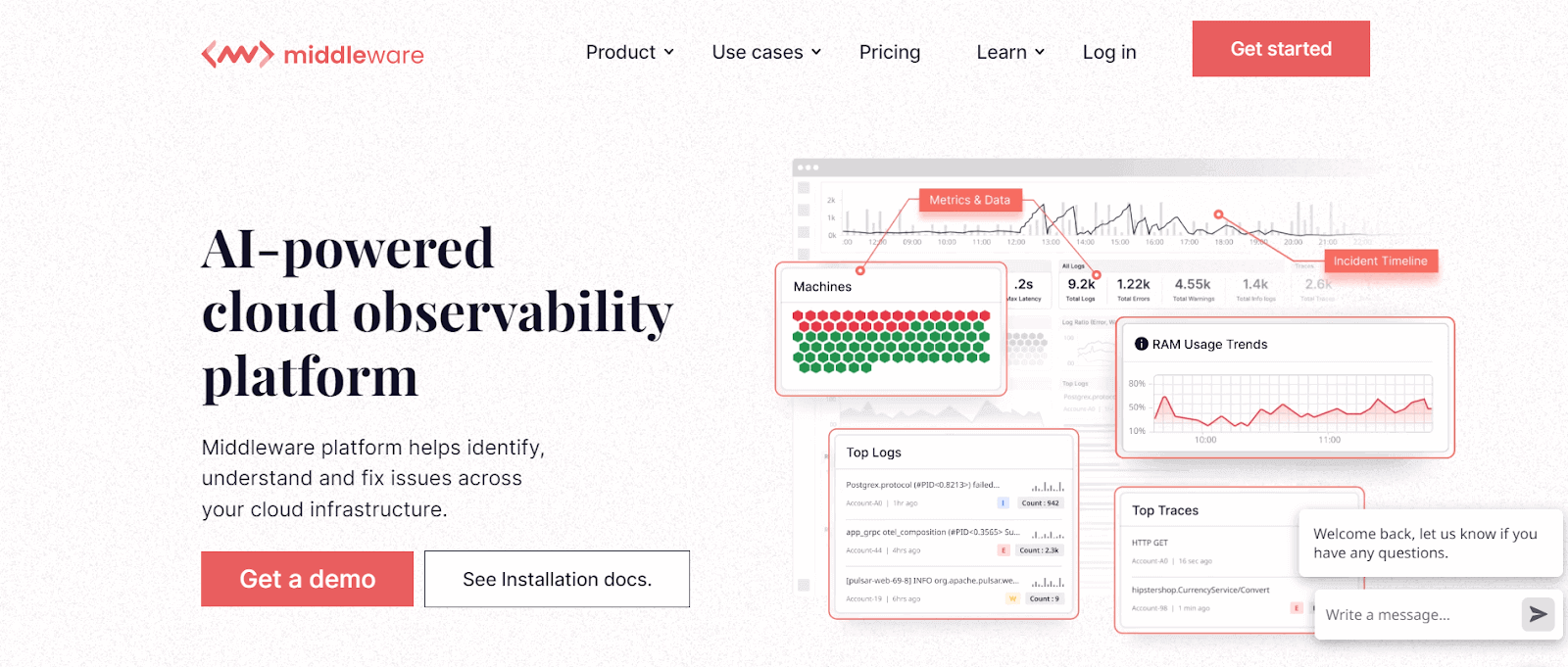
Middleware is an observability platform designed for cloud-native environments and equipped with infrastructure monitoring capabilities. This tool offers real-time visibility to DevOps teams, enabling them to monitor both on-premises and cloud deployments.
With Middleware, teams can assess the overall health of their infrastructure by closely monitoring various components such as applications, processes, servers, containers, events, databases, and more. By providing comprehensive insights and monitoring capabilities, Middleware assists DevOps teams in effectively managing and maintaining their infrastructure.
What makes Middleware stand out as one of the top DevOps monitoring tools?
- Allows gathering metrics from different sources in one single dashboard.
- Supports infrastructure monitoring of Kubernetes, Docker, and Microservice.
- Scalable cloud-based solution.
7. Librato
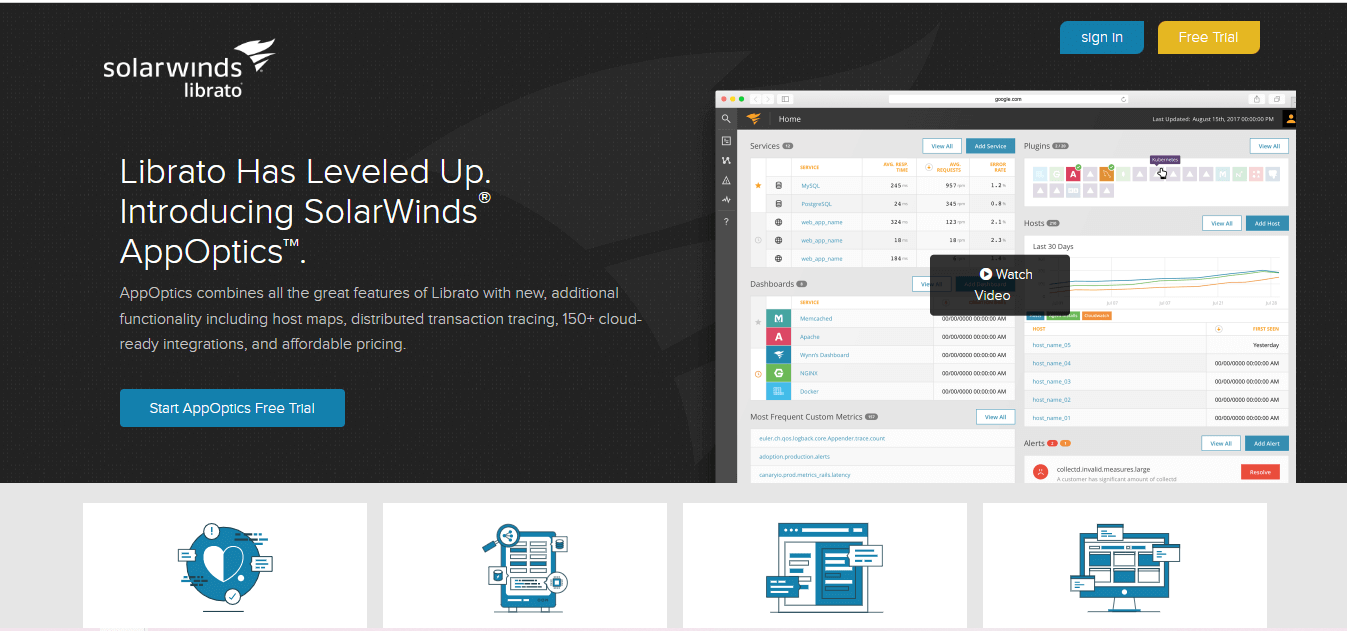
Librato is a DevOps monitoring tool that provides better insight into the performance and health of the system, applications, and infrastructure. You can understand Librato as a monitoring service that provides real-time analytics using metrics from any source. It allows aggregating, transforming, and correlating metrics from different sources like servers, databases, load balancers, web applications, mobile applications, and custom business applications.
What makes Librato stand out as one of the top DevOps monitoring tools?
- You can transform custom infrastructure, business metrics, and applications into insight which helps to make the data-driven decision for optimizing the system.
- You get a single-screen view of the infrastructure with Librato.
- You can easily identify and fix the issues.
- It allows quick identification and resolution of the issues of the application through its simplified service levels and trace-level root cause summaries.
- Offer 150+ cloud-ready integration, which allows you to retrieve data from sources. This ensures that you have all data needed to monitor and optimize the performance.
- Offer services like collecting and analyzing metrics from different sources and delivering visualizations such as graphs, charts, and dashboards. It helps in data monitoring of the application.
- When you complete activity processing on different metrics (CPU usage, memory usage, network traffic, etc.), Librato provides real-time notification.
- You do not have to install Librato, which makes it easy to get started with it.
- The alerts received from Librato are reliable, providing users with accurate information on potential issues in their production environment.
8. Prometheus
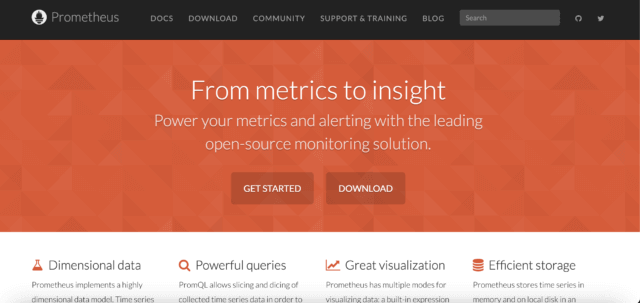
Prometheus is a popular DevOps monitoring tool highly favored among DevOps professionals for its exceptional system monitoring capabilities. It provides a comprehensive solution that incorporates an alert manager, making it an effective tool for detecting and resolving system-related issues.
One of the key advantages of Prometheus is its open-source and community-driven nature. As it continues to gain popularity, more businesses and organizations are integrating Prometheus into their infrastructures. This collaborative effort from the user and developer communities has resulted in constant improvements and updates to the tool.
What makes Prometheus stand out as one of the top DevOps monitoring tools?
- It is an excellent end-to-end monitoring tool with an alert manager.
- It can be integrated with DevOps monitoring tools like Grafana for visualization and alert management.
- It is based on PromQL query language, a “read-only” that provides flexibility to query metrics.
- Uses push gateway to support exporters like HAProxy, StatsD, Graphite, etc.
- It is designed to cater to the requirements of modern large-scale infrastructures, providing pre-built components for storing time series data, real-time graphing, querying collected data, and alerting based on specified conditions.
- Does not depend on distributed storage but is built to work on a single server node.
- Comes with default libraries and servers, available on different OS and applications like Windows, Linux, and MySQL.
- It can store past events for long-term analysis without losing resolution or detail. This action allows users to access historical data and leverage insights into trends and patterns in their system’s performance over time.
- Does not have any dependency and provides Web API for custom development.
- You can add instrumentation to the code using Prometheus Client libraries available in different programming languages like Go, Java, Python, and Ruby.
9. Kibana
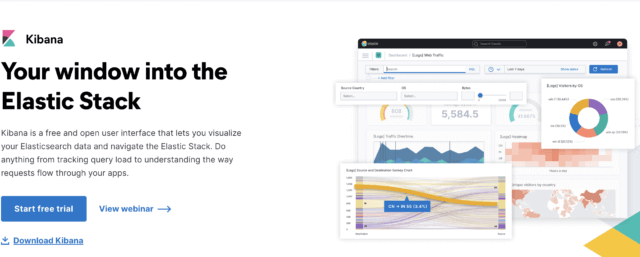
Kibana, an open-source analytics and visualization platform, has established itself as a prominent DevOps monitoring tool. Developers utilize this tool in collaboration with Elasticsearch to construct software applications and log data from various sources. The primary application of Kibana involves exploring, analyzing, and interacting with data housed within Elasticsearch indices.
Initially, Kibana was developed as an open-source project at Elastic. It was to provide a user interface allowing end-users to explore Elasticsearch queries and log in real-time. However, currently, it is utilized as a standalone DevOps monitoring tool by many organizations for analytics needs.
What makes Kibana stand out as one of the top DevOps monitoring tools?
- It has potent querying abilities, such as aggregating and filtering data.
- You can create personalized visualization like lines, bars, and pie charts which can be further customized to fit specific needs.
- You can easily and quickly set up Kibana, allowing you to get started with the tool.
- It allows users to view data that help in the easy identification and fixation of issues in the production of software applications.
- It has an auto-highlighting function that helps users identify potential issues in their log files. You get highlighted search fields that may show issues or errors and enable you for timely fixation.
- You can visualize log files and show necessary data and real-time statistics in graphics that allow an easy understanding of the data.
- Kibana can monitor and scrutinize several stacks of data, which are stockpiled in Elasticsearch.
- A centralized monitoring cluster permits Kibana to monitor and compare numerous deployments of the Elastic Stack (encompassing Elasticsearch, Kibana, Beats, and Logstash), facilitating a straightforward evaluation of data across diverse deployments.
- You have the liberty to configure a retention policy in Kibana, which determines how long data is retained in storage. This feature aids in administering the quantity of preserved data and guarantees that outdated data is discarded when it is no longer necessary.
- Kibana can produce alerts automatically for various metrics, including the state of the cluster, license expiration, and other metrics across the ELK stack (Elasticsearch, Logstash, and Kibana).
10. Splunk
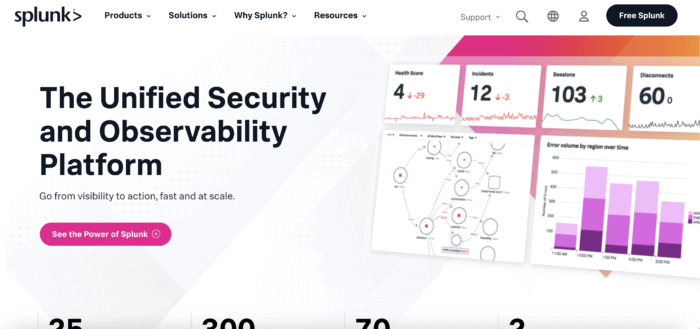
Splunk is a sophisticated DevOps monitoring tool, particularly for analyzing machine data. Splunk is highly popular in DevOps culture because it is the only tool that offers a solution to monitor, search, and analyze data generated by machines and powered by analytics, covers the full stack, and is native to OpenTelemetry. Such data generated uses a web-based interface that permits the inclusion of relevant data into a central index, which helps to find related information easily.
What makes Splunk stand out as one of the top DevOps monitoring tools?
- It has various built-in monitoring abilities, such as support for different technologies like AWS, Azure, GCP, and Kubernetes.
- Using Splunk, you can examine data from networks, servers, and applications.
- It is integrated with AIOps (Artificial Intelligence for IT Operations) into the system, making it easy to find and instantly verify unusual changes in the data.
- It is equipped with a direct troubleshooting feature powered by AI that allows you to detect errors and issues.
- You can create custom reports and dashboards for better visibility and detection of errors in the software applications.
- It is capable of scrutinizing data from a diverse range of sources, such as networks, servers, and applications, making it an all-encompassing solution for the surveillance of machine-generated data.
- Its facile deployment in a production environment is accompanied by the Splunk light feature, which is responsible for transferring data from multiple servers to the primary Splunk engine for analysis.
- The tool indexes data in a way that gives rise to potent analytical insights, allowing organizations to identify areas for improvement with unparalleled accuracy.
- Splunk’s bespoke reports and dashboards furnish precise information, enabling stakeholders to take necessary action expeditiously.
11. Nagios
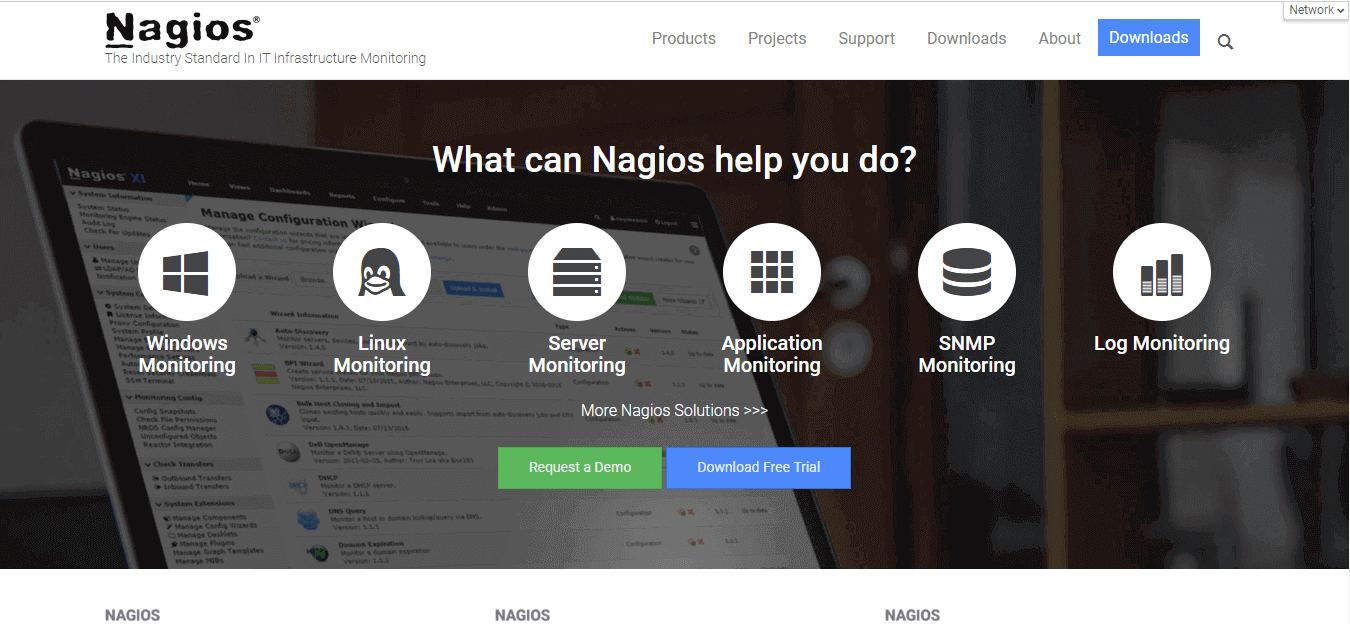
Nagios is a DevOps monitoring tool that monitors networks, servers, and other IT systems. In DevOps culture, Nagios helps monitor systems, services, and applications. Nagios is also well known for its alerting tool that gives real-time notification or alert to the user when the system, infrastructure, and application encounter any error.
What makes Nagios stand out as one of the top DevOps monitoring tools?
- It has a plugin architecture which helps in easy customization and integration with other different software tools like Graphite, PagerDuty, Slack, and Ansible.
- It has a large and active community of users and developers, which gives excellent contributions and support to the projects and can create resources like tutorials and documentation.
- It is a powerful DevOps tool for rapid testing to check the status of the applications and services.
- It can be easily configured on the client and server sides, which makes it a user-friendly DevOps monitoring tool.
- It allows monitoring of various applications across platforms like Windows, Linux, UNIX, and the Web.
- It can supervise network devices, such as routers, switches, and more, to detect network overloading and performance issues.
- It is highly adaptable, offering over 5000 unique add-ons for monitoring servers. These add-ons can be used for both agent-based and agentless monitoring, giving users the flexibility to choose the best approach for their specific needs.
12. Akamai mPulse
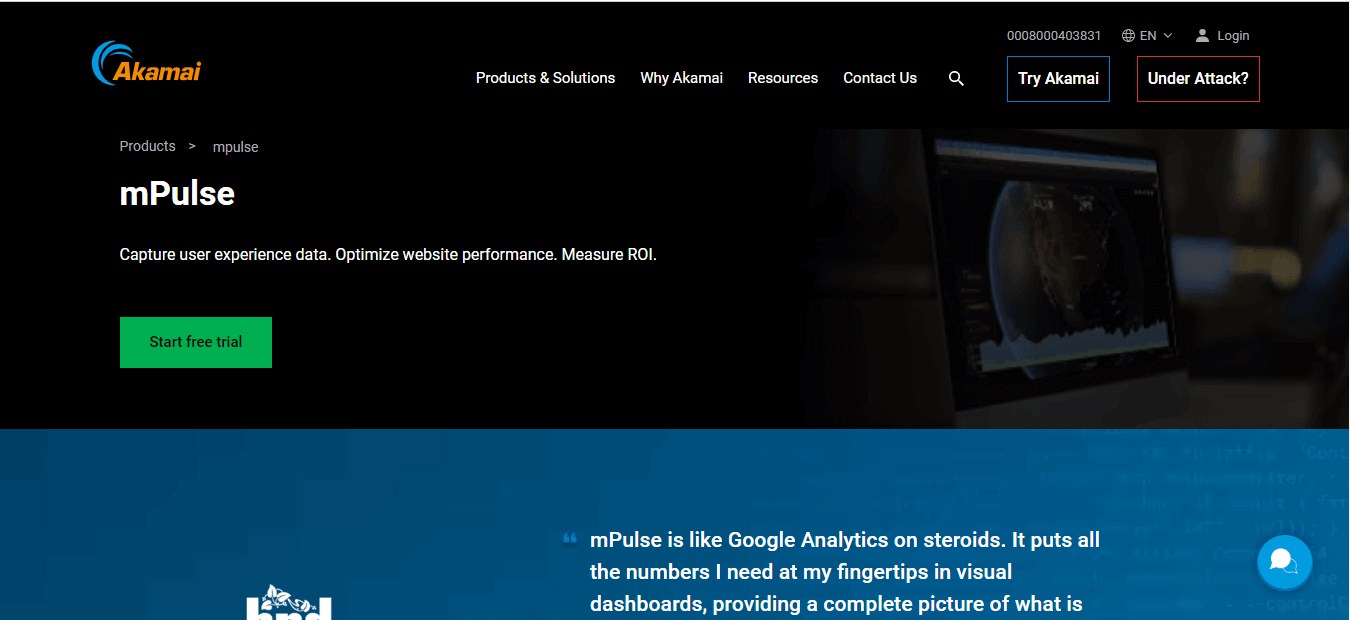
Akamai mPulse is a specialized DevOps monitoring tool crafted for authentic user supervision. It empowers DevOps groups to assemble and examine user engagement and demeanor information when browsing a website or operating an application.
By embedding the mPulse code snippet onto a target web page or app, programmers can harvest beyond 200 business and performance criteria from each user session. This information encompasses application performance and user engagement parameters such as session and user agent data, bandwidth, latency, and loading times.
What makes Akamai mPulse stand out as one of the top DevOps monitoring tools?
- One of the fundamental aspects of Akamai mPulse is its effortless deployment, thus making it an easily accessible tool for DevOps groups.
- It is operative for monitoring both websites and native applications, providing an inclusive solution for application monitoring.
- The tool permits the formation and tracking of customized criteria and the production of individualized dashboards. This characteristic furnishes DevOps groups with adaptability and customizability alternatives to track the metrics most significant to their specific applications or business needs.
- Akamai mPulse confers dependable and legitimate performance data and feedback, which can facilitate developers in recognizing and addressing dilemmas promptly.
- The system dashboards provide real-time user activity discernment, allowing for Agile and well-informed decision-making.
13. AppDynamics
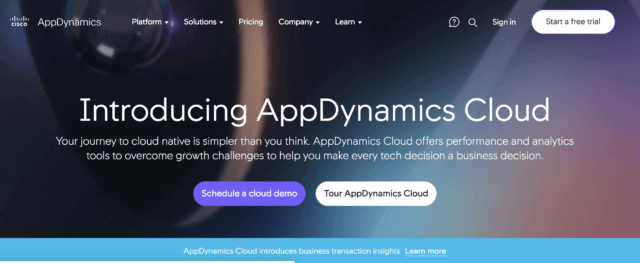
AppDynamics is an exceedingly DevOps monitoring tool that facilitates the uninterrupted monitoring of applications, infrastructure, and networks, whether on-premises or in the cloud. DevOps teams can use this tool to accumulate data from diverse sources, such as infrastructure elements, Application Programming Interfaces (APIs), database transactions, and end-user sessions.
This information aids in maintaining total visibility over the technological framework, allowing teams to promptly respond to any performance issues that may arise, hence negating the detrimental effects on the customer’s experience.
What makes AppDynamics stand out as one of the top DevOps monitoring tools?
- It can accommodate numerous platforms, including Microsoft Azure, IBM, Kubernetes, AWS, etc. This broad range of coverage ensures that it can be utilized to monitor diverse technologies, providing a versatile solution for DevOps teams.
- AppDynamics incorporates rapid root-cause diagnostics driven by machine learning, which effectively helps teams rapidly pinpoint the underlying cause of any performance issues.
- This DevOps monitoring tool allows monitoring, troubleshoots, and fixing issues in real time of the applications.
- Offer a set of tools to test the software application before releasing it into the market. Such tools include real-time monitoring, root cause analysis, custom dashboards, etc.
- It does not require any code instrumentation and can create dashboards to monitor particular metrics without the need to write any code.
- Possesses an effortless ability to monitor hybrid environments, which is quite helpful for organizations migrating to the cloud or those utilizing a combination of on-premises and cloud resources.
14. BMC Helix Operations Management
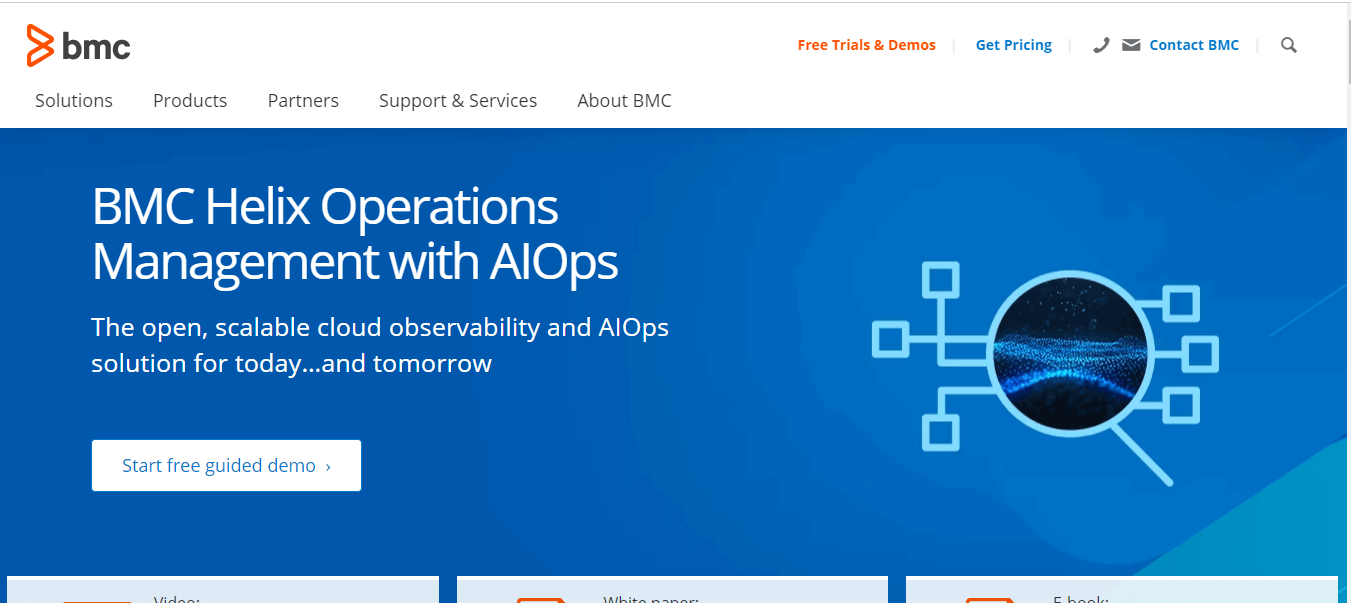
BMC Helix Operations Management is a highly intelligent DevOps monitoring tool that leverages predictive analytics to monitor and ensure the performance and accessibility of IT services. It can function seamlessly across various environments such as cloud, On-premises, and hybrid setups. The tool comes equipped with an array of features, including service-centric monitoring, advanced event management, root cause isolation, and intelligent automation, all bolstering the overall performance and accessibility of IT services.
What makes BMC Helix Operations Management stand out as one of the top DevOps monitoring tools?
- It has AI-powered proactive alerting capabilities that allow us to find bugs before they escalate into more serious problems.
- It allows DevOps teams to respond promptly to any errors or issues and resolve them promptly.
- The tool further provides probable cause analysis, which helps DevOps teams to identify the root cause of any given problem and take corrective action accordingly.
- It adheres to a SaaS (Software-as-a-Service) business model, which renders deployment a breeze and allows for remote access via the Internet.
- The tool also boasts customizable dashboards and reports, simplifying data access and making it more understandable.
- Offers predictive alerts via machine learning and advanced analytics, which can aid organizations in developing plans to mitigate future events.
15. New Relic One
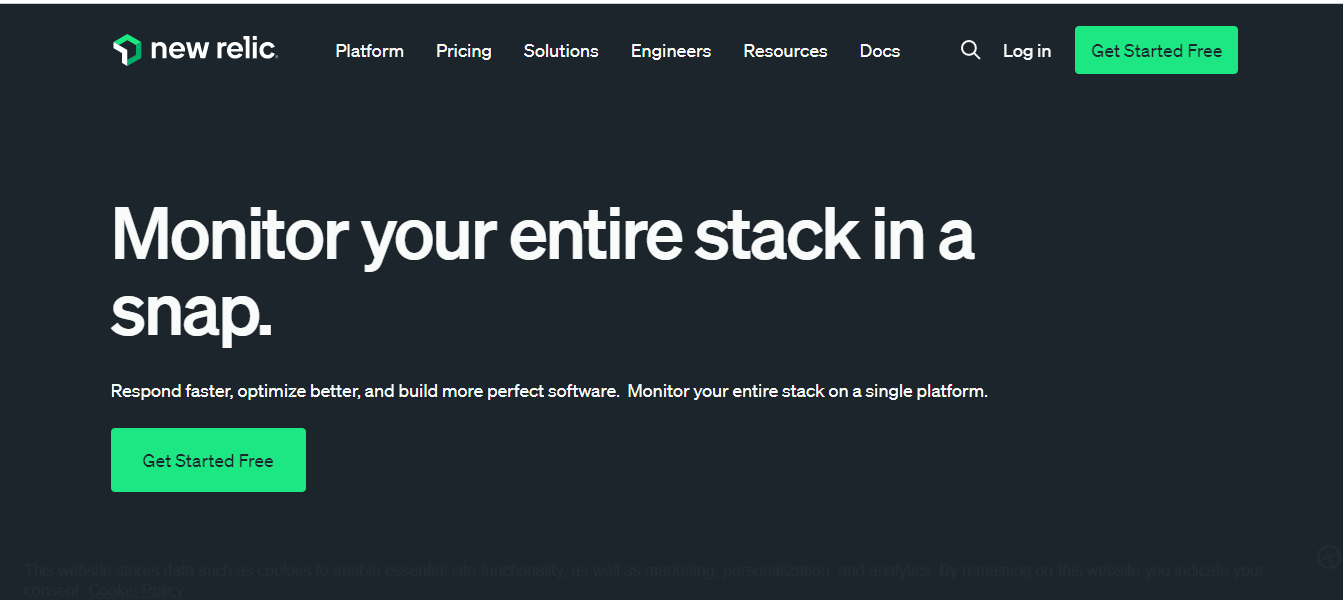
New Relic One is an all-encompassing and uninterrupted DevOps monitoring tool that bestows absolute observability of the software stack. It accords DevOps teams with a singularly converged platform that amalgamates four telemetry data classes: events, logs, metrics, and traces. This permits teams to monitor and scrutinize all aspects of the software stack from one location, resulting in a more streamlined monitoring process.
What makes New Relic One stand out as one of the top DevOps monitoring tools?
- It can supervise browser and mobile sessions, conferring perceptibility into the ultimate user experience.
- It provides perceptibility into servers, on-premises virtual machines, and cloud-native infrastructure.
- Encompasses both real user monitoring and synthetic monitoring capabilities, enabling teams to oversee the performance of their applications from multiple standpoints.
- Operates on a pay-as-you-go model, empowering users to remunerate only for the data they necessitate.
- Users are further endowed with a monthly ingestion limit of 100 GB gratis data. It reduces costs and makes it more convenient for small-scale entities to espouse the tool.
- It provides automatic linkage between logs, errors, and traces. Such a feature expedites the root cause analysis by providing teams with a comprehension of the interconnections between distinct software stack components.
16. Sumo Logic
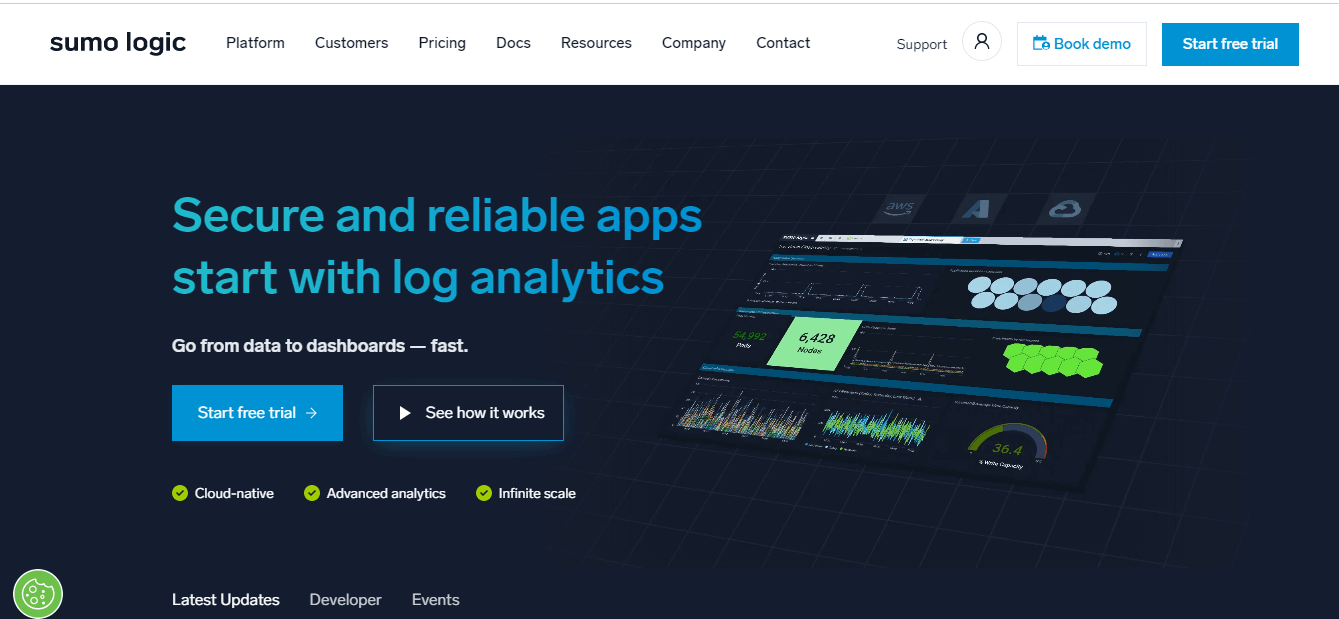
Sumo Logic is an open-source DevOps monitoring tool particularly used for monitoring servers, applications, and infrastructure components, analyzing and alerting data from different sources. It was initially developed by Sensu Inc in 2012, and now it has become one of the most used DevOps monitoring tools.
It can be leveraged by integrating with AI-native test orchestration and execution platforms like LambdaTest. It provides scalable, secure, and reliable test orchestration for end-users at different stages in the DevOps Life cycle. The LambdaTest integration with Sumo Logic allows real-time visibility on key metrics and supports usage and test data analytics. With this, you will have comprehensive insights into the software application development process and enable the team to make informed decisions for faster release.
What makes Sumo Logic stand out as one of the top DevOps monitoring tools?
- It allows the DevOps team to monitor the working of the microservice-based applications through a single platform, which includes performance metrics, logs, and event data.
- Monitors diverse system and software application checks like HTTP checks, TCP checks, and log analysis. It provides process monitoring that shows the functionality and performance of the software infrastructure.
- Monitors cloud security and business intelligence features.
- Automatically detect new services and infrastructure and display them in pre-configured dashboards. It will help you get a quick overview of software applications.
- Provides service maps that help you see how diverse components of software applications are associated and depend on each other.
- Monitors user interaction with your software application and detects any issue in the page slowing it down.
- Utilizes machine learning algorithms to find anomalies in the software application and automatically detect any root cause.
- Provides a database of performance metrics for known software stacks that help compare software application performance to industry standards and best practices.
- Provides pre-built dashboards and visualization for different use cases that help detect any issue within your software applications.
17. Dynatrace
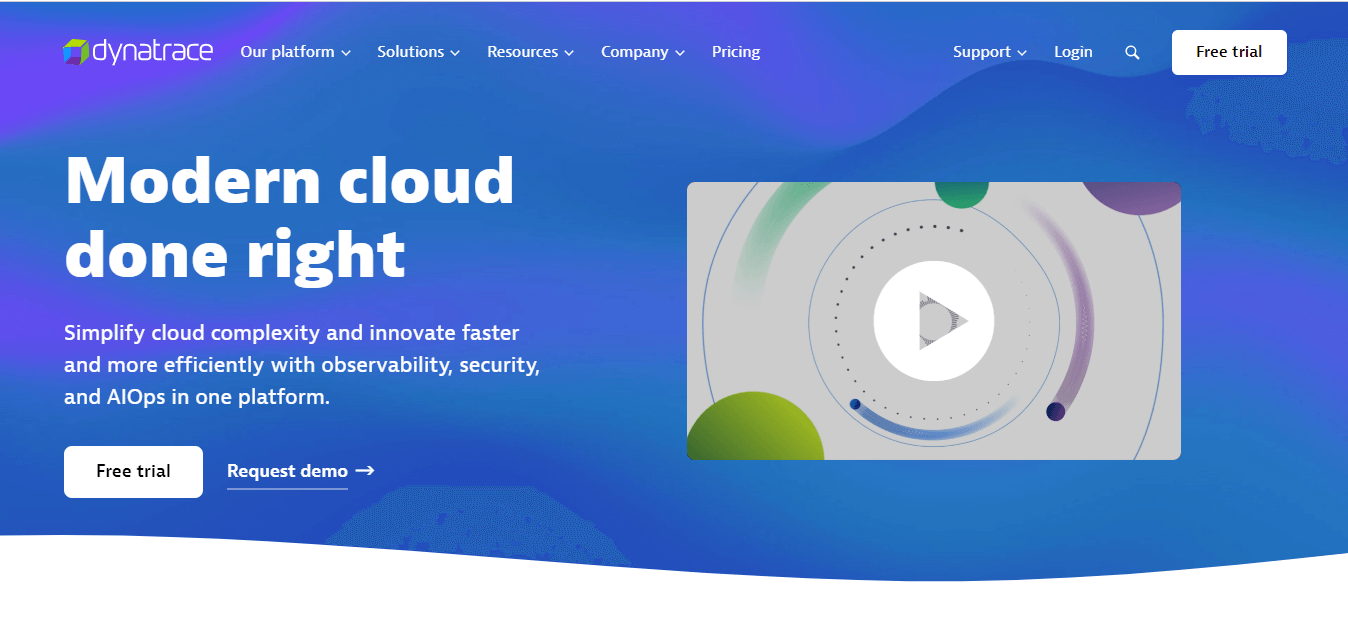
Dynatrace is a comprehensive DevOps monitoring tool that can meticulously test software application logs without any negative impact or clashes on the server. Dynatrace’s exquisite design allows it to operate within the application process while not exceeding the 10 MB memory consumption threshold, reducing server overhead.
Further, it is non-reliant on server restarts to include or exclude agents from application servers, significantly saving valuable time and resources.
What makes Dynatrace stand out as one of the top DevOps monitoring tools?
- The various capabilities of Dynatrace extend beyond test logs; it can effectively yield valuable insights into the performance of an application. For instance, it can illustrate the duration of each phase of an application’s execution and provide a transactional flow.
- It can also explicitly highlight any issues or errors in production workflows.
- It identifies deviations from standard benchmarks, detects any unusual activity within the application or network, and promptly alerts users.
- Offer a clear and concise overview of the software application’s performance, making it accessible and understandable to even non-technical users.
- Enables the monitoring of multiple facets within a unified platform, such as real users, applications, clouds, servers, networks, and infrastructure.
- Provide effortless deployment process and automated dependency discovery, which considerably saves time and mitigates the possibility of errors during deployment.
- Its versatility is demonstrated by its support for various technologies such as WebUI, Java, node.js, and .NET-based applications.
18. Grafana

Grafana is a DevOps monitoring tool and open-source analytics and interactive visualization platform. Grafana is known to support data presentation methods utilizing pluggable panel architecture. You can use this tool in a DevOps environment to monitor and analyze data from different sources.
What makes Grafana stand out as one of the top DevOps monitoring tools?
- It has an alerting feature, and Grafana is integrated with other alerting systems like Alertmanager.
- Utilizes a user-friendly interface that helps end-users to create, edit and share dashboards.
- It comes with dashboard templating, allowing customization of dashboard setup to suit every need.
- It boasts the capability to generate annotations on graphs and acquire data from a broad range of data sources.
- It has the functionality to enable kiosk mode and playlist options, which can be used to exhibit dashboards on TV screens and conceal extraneous interface components.
- It has extended functionalities with plugins like Zabbix, Influx Admin Panel, etc.
- It includes straightforward-to-code alert hooks, which enable the creation of custom notifiers for a diverse array of notifications and alerts.
19. Zabbix
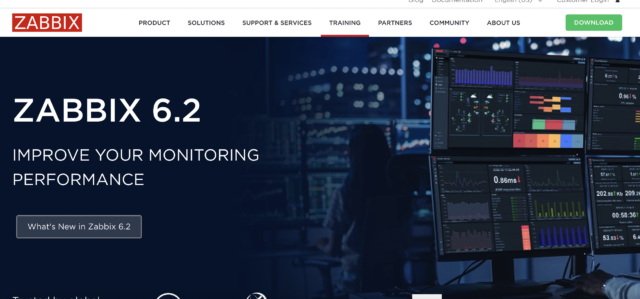
Zabbix is an open-source DevOps monitoring tool and solution for IT components like software application networks, servers, virtual machines, and cloud services. Zabbix also provides monitoring services for different end-users in a multi-tenant environment.
What makes Zabbix stand out as one of the top DevOps monitoring tools?
- Zabbix can gather data from any source at custom intervals. Uses backend database values to determine any flexible issue threshold in the software applications. For example, when certain conditions are met, like when the server’s CPU usage goes beyond a certain threshold, you get a notification.
- Based on the escalation schedule, recipients, and media types, Zabbix customizes sending notifications. It helps you ensure the correct user is notified at the right time.
- It allows you to store data over time which can be accessed easily at any time for reporting and analysis.
20. Datadog
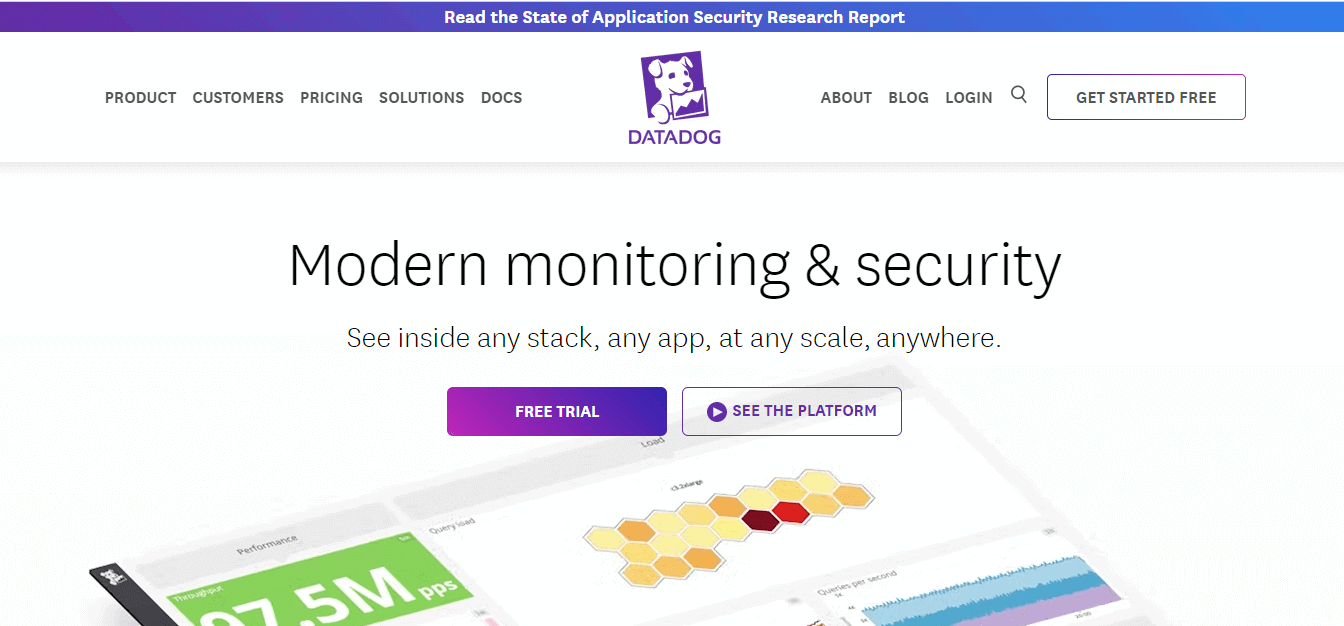
Datadog is a cloud application DevOps monitoring tool used to compute performance metrics and event monitoring for infrastructure and cloud services. Datadog also provides SaaS-based infrastructure monitoring services through its multiple integrations. This enables the DevOps team to monitor the cloud environment to visualize the health of your infrastructure.
What makes Datadog stand out as one of the top DevOps monitoring tools?
- Open source and easy to analyze code and understand how it collects metrics.
- Can notify appropriate individuals when any critical alerts are triggered.
- Comes equipped with ready-made integrations for commonly used web servers, programming languages, databases, and code repositories.
- Boasts an added convenience in the form of pre-configured dashboards for each installed integration. This lets you easily access crucial metrics and visualize data for every component you track.
- Users can also customize their dashboards to visualize multiple services and applications, providing a comprehensive view of your IT infrastructure.
- It enables seamless monitoring and collaboration by integrating with LambdaTest, which helps you to log bugs while performing cross browser testing of your websites or web apps from LambdaTest’s real device cloud to Datadog.
21. InfluxDB
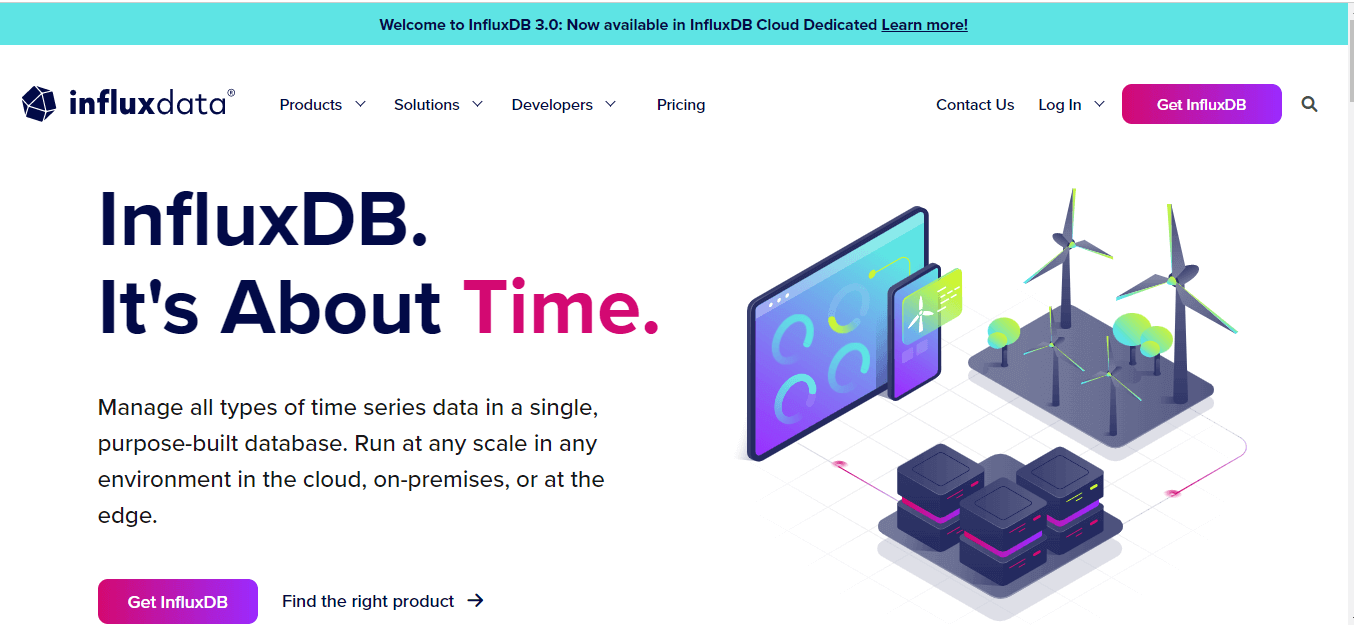
InfluxDB is a DevOps monitoring tool that is highly effective for keeping track of cloud-based applications and microservices. It is also renowned for its proficiency in working with modern distributed systems.
What makes InfluxDB stand out as one of the top DevOps monitoring tools?
- Its extraordinary ability is its specialized language InfluxQL.
- The InfluxQL language enables the execution of highly specific and adaptable searches of metrics.
- By employing InfluxQL, one can easily and promptly access precise information on their system.
- InfluxDB also boasts a built-in feature enabling alerting upon fulfilling specific conditions.
22. ChaosSearch
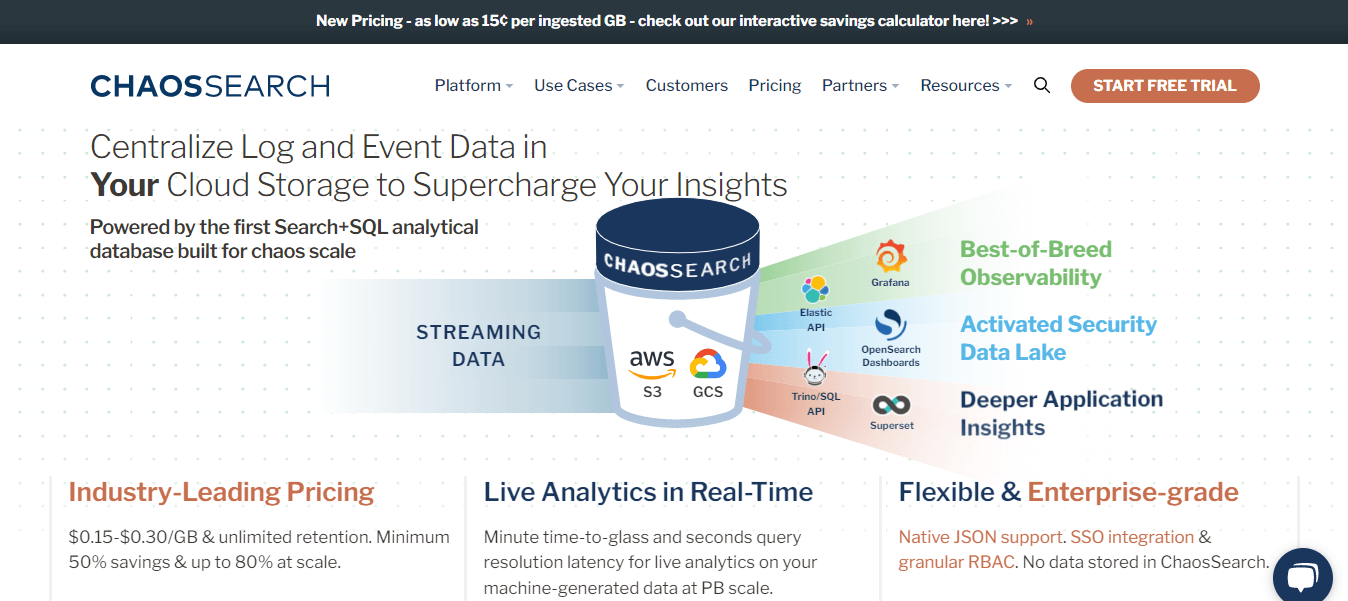
ChaosSearch is a DevOps monitoring tool that offers an innovative approach for continuous monitoring and managing logs from multiple sources. ChaosSearch is well known for combining data indexing and querying with data lake economics to create a top-of-the-line log management solution.
What makes ChaosSearch stand out as one of the top DevOps monitoring tools?
- DevOps teams can easily assimilate logs and event data from many origins and preserve them in Amazon S3 or Google Cloud Storage buckets.
- The tool indexes the data through its proprietary technology, making it convenient to promptly scrutinize and obtain discernment from the data without necessitating its migration or deploying a distinct ETL process.
- It can perform SQL querying and full-text search, as well as supporting machine learning.
- When you use ChaosSearch, you can easily find the required information on the work of monitoring and data analysis.
- It comes with an index of 1000+ million documents and gives accurate results in less time.
23. Elastic Stack
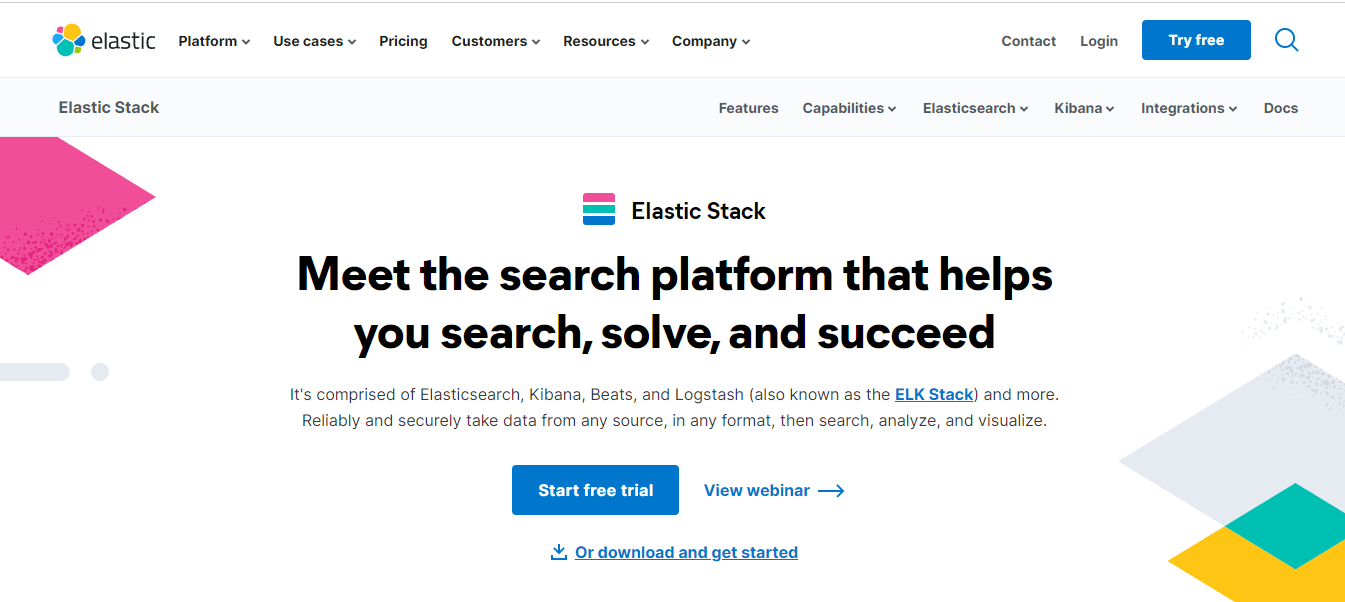
Elastic Stack is a DevOps monitoring tool that comprises three open-source tools: Elasticsearch, Logstash, and Kibana. Elastic Stack is also known as a log analysis tool for effective monitoring, SEO, troubleshooting and compliance, and business intelligence.
What makes Elastic Stack stand out as one of the top DevOps monitoring tools?
- It is open-source and free to use. With this, you don’t have to pay any cost for software licensing fees to access it.
- Offer centralized logging ability for collecting server logs from cloud environments into a single searchable index.
- Provides many hosting options; organizations with the right resources can install it on a local server and manage it in-house.
- You can monitor and interpret data in real time by converting it into visual representations like graphs and histograms.
24. Elasticsearch
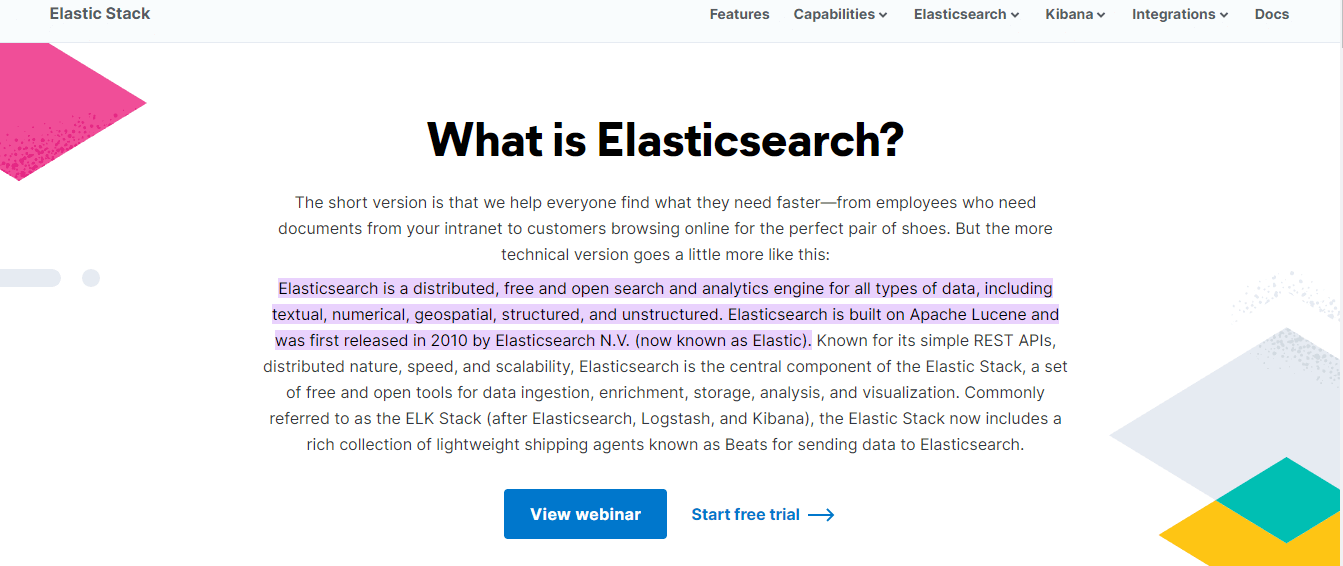
Elasticsearch is another open-source DevOps monitoring tool that is developed on Java. Being a Lucene-based application, Elasticsearch is scalable and deals with the issues noted with Big Data. It is also widely used for content search, data analysis, and handling queries on projects like Mozilla and GitHub.
What makes Elasticsearch stand out as one of the top DevOps monitoring tools?
- It is regarded as a database that can be accessed through a REST service.
- Its operation is quite simple, and the experience is unparalleled.
- Elasticsearch has many out-of-the-box features, including full-text search, customized document scoring, suggestions, and result highlighting.
- Plugins such as Logstash and Kibana are available to display metrics and logs.
- The search engine control that Elasticsearch offers is a standout feature.
- With exceptional documentation, getting started with Elasticsearch is easy. It makes it the perfect tool for DevOps teams who need to rapidly and efficiently monitor and analyze data.
- It is an excellent option for aggregating and searching logs in production environments.
25. Icinga
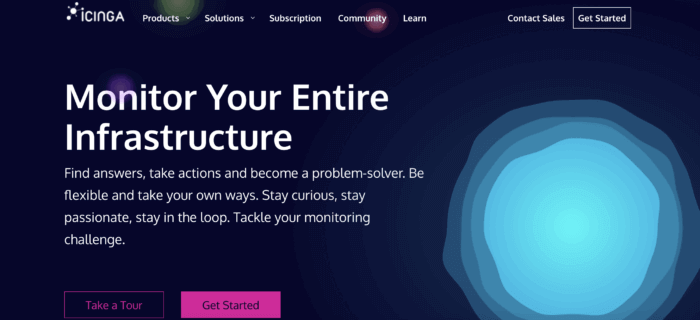
Icinga is an open-source DevOps monitoring tool that ensures the effective and efficient functioning of the various components of a software system. Icinga allows DevOps teams to deploy automatic checks and assess different aspects of their infrastructure, including servers, network devices, applications, and services.
What makes Icinga stand out as one of the top DevOps monitoring tools?
- It allows you to check the availability of the network resources and notify if any issue is detected.
- You can regularly check the working of the software application, service, and infrastructure and send alerts if something goes wrong.
- You can generate actionable data for performance reporting.
- It is compatible with Nagios plugins and configuration files.
- Icinga’s adaptability is a valuable asset, as teams can tailor the tool to meet their specific requirements.
- It is equipped with various notification methods, including email, SMS, and Slack messages, allowing teams to receive alerts in their preferred mode of communication.
- Icinga’s compatibility with other DevOps tools makes it a superior monitoring tool, like Puppet and Chef.
26. OpenNMS
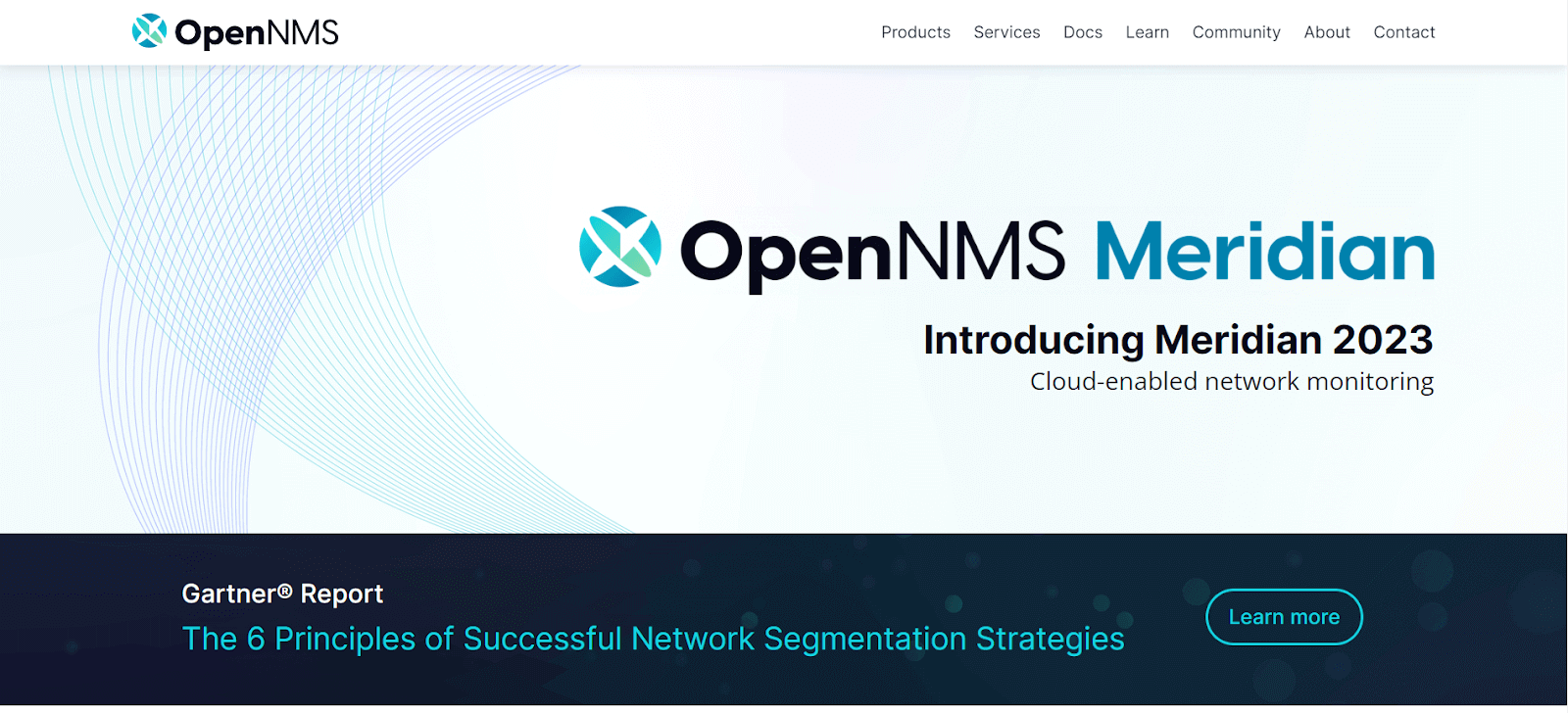
OpenNMS is open-source and the world’s fully enterprise-grade DevOps monitoring tool that provides a range of features to monitor and effectively manage network resources.
What makes OpenNMS stand out as one of the top DevOps monitoring tools?
- It offers a very rich plugin architecture.
- Comes with excellent alerting and reporting features that give the developers and testers real-time notifications.
- Automatically discover and add devices to network inventory, lowering manual efforts and monitoring all devices.
- Allows monitoring of network performance metrics like bandwidth utilization, response time, and packet loss.
- You can also create custom preferences reports and graphs.
- It is easy to detect and resolve network issues like device failures and connection issues.
- You can monitor service availability and performance, ensuring SLAs are met.
- Supports SNMP-based monitoring, which helps collect and analyze SNMP data from network devices.
27. Epsagon
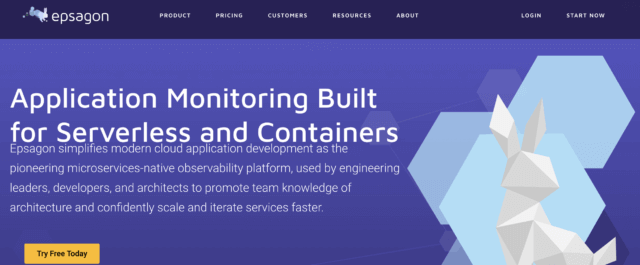
Epsagon is also a cloud-based system application DevOps monitoring tool that allows optimization of the microservices architecture of the business. In other words, it allows end-to-end visibility into modern applications, microservices, and serverless structures.
What makes Epsagon stand out as one of the top DevOps monitoring tools?
- You can monitor and troubleshoot issues in microservice environments.
- It is designed to enhance the efficiency of the Dev and Ops teams by allowing fast detection of errors, correlating data, and identifying root causes.
- It eases monitoring cloud services and container orchestrators like AWS ECS and Kubernetes.
- Allows CPU and memory utilization monitoring for your containers and duration, with starting of serverless functions.
- Automatically install applications and services, thereby mitigating the requirement for manual configuration and simplifying monitoring initialization.
- Gathers performance metrics encompassing response time, error rates, and resource utilization to offer insights into application performance.
- Facilitates compliance monitoring, allowing visibility into compliance-related events like access attempts and changes to configuration settings.
28. StatsD
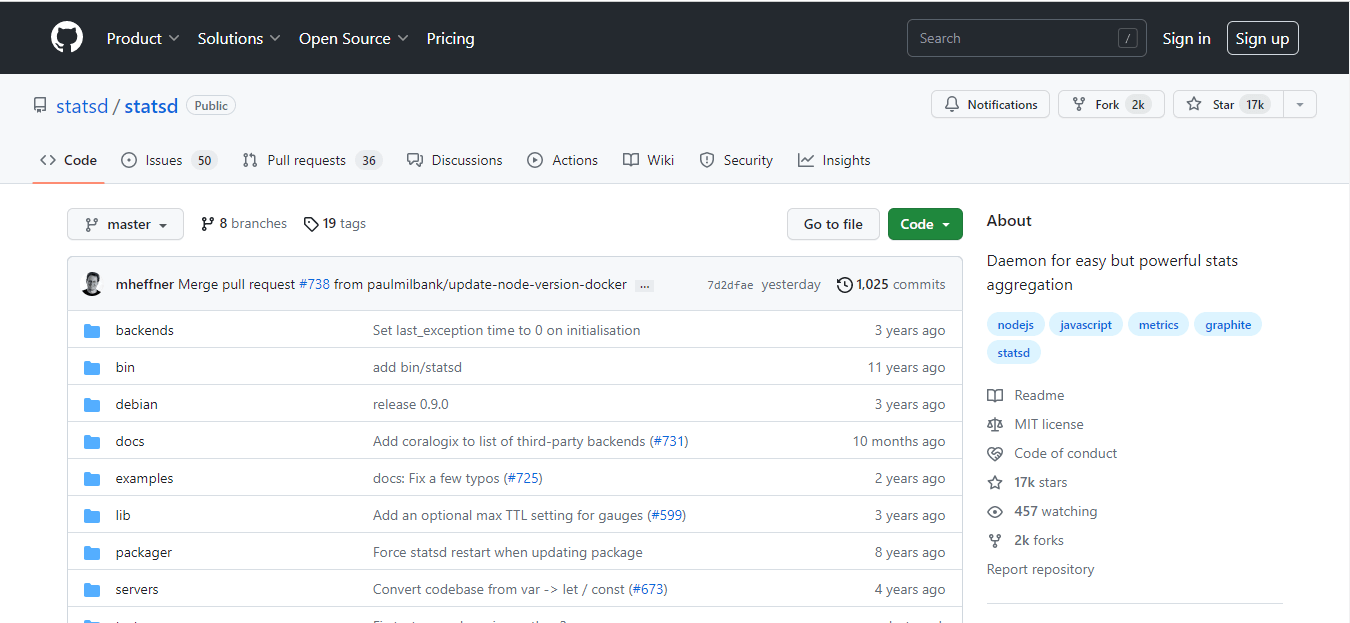
StatsD is a DevOps monitoring tool that helps collect and aggregate metrics from diverse applications and services, giving insight into the performance and behavior of the software applications, systems, and services.
What makes StatsD stand out as one of the top DevOps monitoring tools?
- It is used with other monitoring tools like Graphite, InfluxDB, and Grafana for data storage, analysis, and visualization.
- It is a pull-based system.
- Provide simple and easy-to-use protocol.
- Being lightweight and efficient tools, it can collect information on performance metrics from different systems and applications.
- StatsD aggregates metrics using highly customizable rules, empowering DevOps teams to generate informative metrics from raw data.
- Enhances customizable dashboards and graphs for visually presenting metrics, thus making it easier to monitor performance and identify trends.
29. Collectd
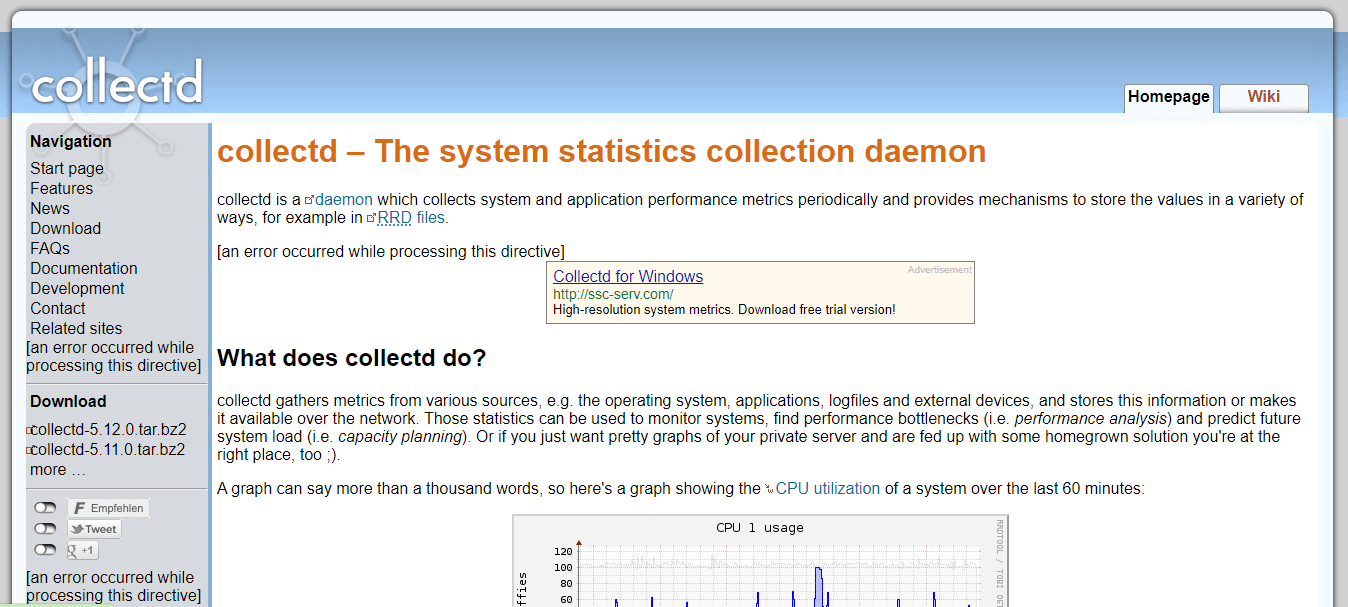
Collectd is an open-source DevOps monitoring tool mainly used in DevOps environments to collect and store performance metrics from different systems and applications.
What makes Collectd stand out as one of the top DevOps monitoring tools?
- It can be easily integrated with other DevOps tools.
- Comes with a large and active community that facilitates learning and troubleshooting.
- It aggregates data using customizable rules and generates real-time alerts based on user-defined rules, allowing DevOps teams to identify and resolve issues quickly.
- Supports data visualization through customizable dashboards and graphs and integrates with popular DevOps tools such as Graphite, Elasticsearch, and InfluxDB.
- Supports plugins, enabling DevOps teams to customize metric collection and aggregation.
- It can monitor performance metrics such as CPU usage, memory usage, and disk I/O, providing valuable insights into system performance.
30. Sematext
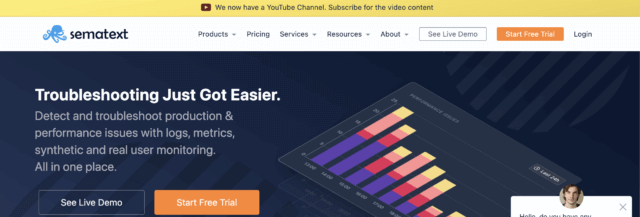
Sematext is an all-in-one DevOps monitoring tool that allows easy and quick troubleshooting of issues. With Sematext, you get end-to-end visibility into modern applications and infrastructure.
What makes Sematext stand out as one of the top DevOps monitoring tools?
- It has predefined dashboards to explore and alert the organization.
- Provides a unified platform for both monitoring and troubleshooting systems like logs, metrics, and traces.
- It delivers distributed tracing capabilities, facilitating DevOps teams to trace requests across multiple services and detect performance bottlenecks.
- Gathers and demonstrates real-time metrics such as response time, error rates, and resource utilization, providing comprehensive insights into application performance.
- Offers centralized log management, empowering DevOps teams to accumulate, save, and analyze logs from diverse sources, including applications, servers, and network devices.
- Integrates with popular DevOps tools such as Kubernetes, Docker, and AWS, facilitating the effortless incorporation of monitoring and logging into existing workflows.
31. Honeycomb

Honeycomb is a DevOps monitoring tool appropriate for DevOps teams to debug, observe and enhance live production software. The UI/UX of Honeycomb helps users to observe code as they are released.
What makes Honeycomb stand out as one of the top DevOps monitoring tools?
- Supports the open-source and vendor-neutral OpenTelemetry standard.
- Offers high-resolution metrics that include traces, logs, and performance data, enabling teams to gain visibility into application performance.
- It offers distributed tracing capabilities, enabling you to trace requests across multiple services and detect performance issues easily.
- Helps the DevOps team with real-time querying and analysis of monitoring data that can be done with Honeycomb, thus empowering them to detect and address issues promptly.
- Provides customizable dashboards and reports, enabling DevOps teams to visualize and analyze real-time monitoring data.
32. Monit
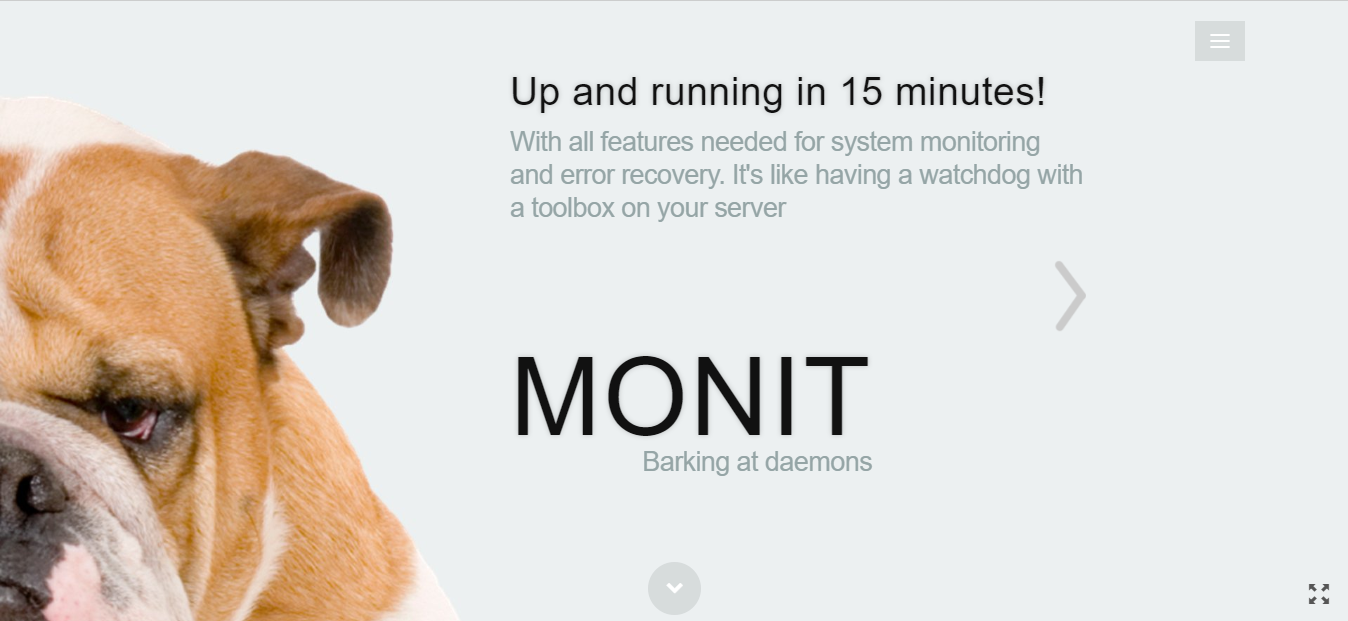
Monit is a DevOps monitoring tool that helps monitor other server applications. However, you should not be confused with Monotone, which is nothing but an open-source version of Monit. It has developed for over 20 years and is still actively maintained by its original author.
What makes Monit stand out as one of the top DevOps monitoring tools?
- It has an alerting feature and allows you to send email notifications on encountering errors.
- It automatically starts the failed process, lowers downtime, and ensures critical systems remain online.
- Give detailed reports on the system status, like CPU usage, memory usage, and disk space utilization.
- It can be easily configured and customized to meet the needs of the software application.
- Integrates with tools like Ansible and Chef for easy monitoring of existing workflow.
33. BigPanda
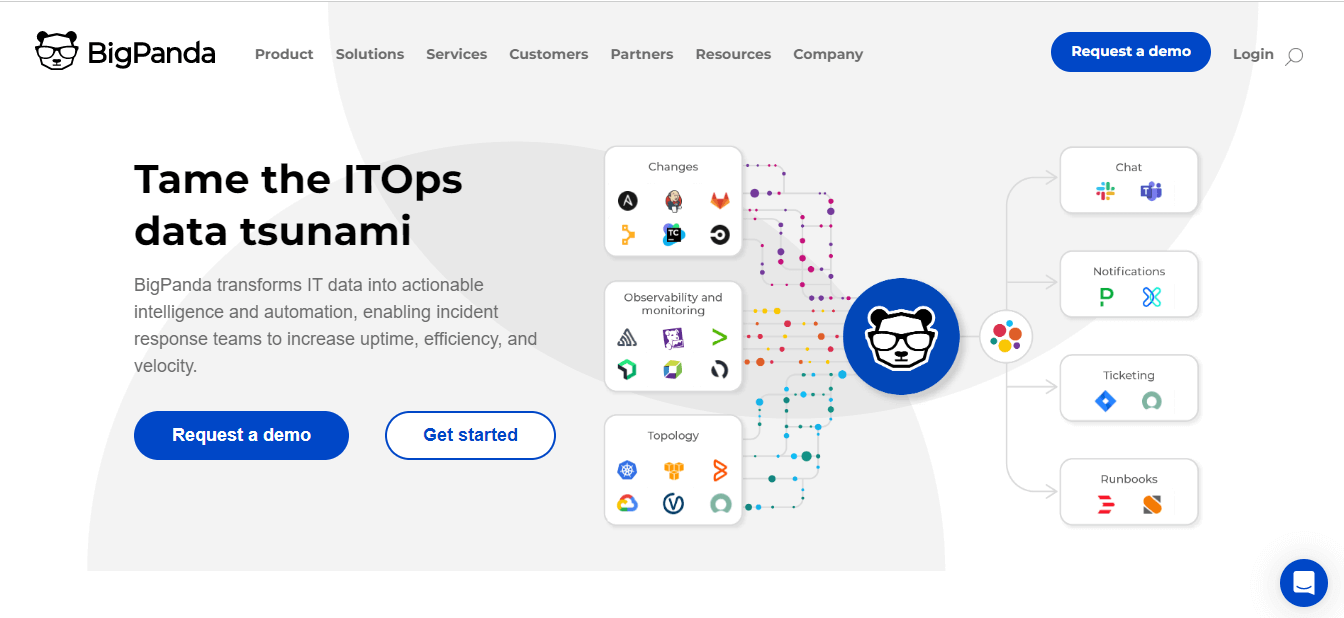
BigPanda is a cloud-based DevOps monitoring tool developers use to automate their build and monitor the workflow and deployment. BigPanda, as a DevOps monitoring tool, uses a machine learning algorithm to correlate and aggregate monitoring data from different sources and give a unified view of system health.
What makes BigPanda stand out as one of the top DevOps monitoring tools?
- Offer API that helps developers to design and manage a work pipeline where you can configure different build steps like building Docker image and AWS Lambda function.
- Offers a root cause analysis of incidents, which helps DevOps teams identify the underlying cause of issues and preempt future occurrences.
- To facilitate real-time visualization and analysis of monitoring data, the platform comes equipped with customizable dashboards and reports.
- It seamlessly integrates with popular DevOps tools such as PagerDuty, Jira, and Slack, enabling users to incorporate monitoring into their existing workflows.
- Support monitoring across multiple cloud environments, including but not limited to AWS, Azure, and GCP.
Bonus Tool: Ping Bot

Ping Bot is an uptime monitoring tool that tracks your web assets, including websites, apps, databases, and third-party services, ensuring everything runs smoothly. It alerts you when issues arise and goes beyond basic monitoring by providing detailed insights into incident management. With comprehensive reports on uptime and response times, it helps you diagnose and resolve issues quickly. Key features include custom monitoring, vendor tracking, and configurable alerts, allowing you to focus on critical problems efficiently.
How to Choose the Best DevOps Monitoring Tools?
Choosing the right DevOps monitoring tools can be challenging for some developers. This may be due to unawareness of the key factors that should be considered while selecting the best DevOps monitoring tools. However, choosing the optimal DevOps monitoring tools is paramount to guarantee your DevOps operations’ success.
In addition, you might ask yourself what kind of data you wish to collect and whether you want to monitor network traffic, server load, or application performance. Answers to these questions will help you start choosing top DevOps monitoring tools.However, the data you want to collect will determine the most appropriate DevOps monitoring tools for your software project. There are other factors as well, which should not be avoided. Following are some points to consider to choose DevOps monitoring tools:
- You must look for full-stack end-to-end observability while choosing the most reliable and appropriate DevOps monitoring tools. It will ease continuous DevOps monitoring that will transform business outcomes.
- When you choose a tool, consider that it offers integration and interoperability between AIOPs, ITSM, and operational tools.
- The tool should be able to accelerate remediation and troubleshooting.
- Research the DevOps monitoring tools obtainable on the market. Consider aspects such as functionality, user-friendliness, pricing, and support.
- Give priority to tool integration. Seek tools that can seamlessly integrate with your current DevOps tools and systems.
- Take scalability and flexibility into account. Choose monitoring tools that can effortlessly scale up or down according to your requirements.
- Before making a final decision, evaluate the DevOps monitoring tools to guarantee they satisfy your necessities. You can do this by conducting a pilot project or establishing a proof of concept.
Conclusion
In this blog, we learned about DevOps monitoring, its significance, and its tools. Let’s summarize it a bit. DevOps monitoring is the practice that includes observing the behavior and performance of software applications and infrastructure in the DevOps environment.
To effectively monitor the above practice, the availability of DevOps monitoring tools is expansive and varied, encompassing many solutions catering to various organizational workflows. Be it a comprehensive platform equipped with an extensive range of features or a specialized tool dedicated to monitoring a specific aspect, you can find a DevOps monitoring tool that suits your requirements.
This blog post explores a handful of top-tier DevOps monitoring tools, each with unique strengths and weaknesses. To choose the appropriate DevOps monitoring tool, meticulously evaluate your organization’s needs and priorities and opt for the tool that aligns with your objectives. With a plethora of exceptional DevOps monitoring solutions available, now is the perfect time to invest in a tool that enhances your organization’s monitoring capabilities.
Frequently Asked Questions (FAQs)
What types of data can DevOps monitoring tools collect?
It includes different types of data, which includes software application logs, server metrics, user feedback, and network traffic data.
How do DevOps monitoring tools help improve software application performance?
It provides real-time information on the software application performance, which helps teams to fix the issue quickly. You can monitor key metrics and analyze data that help optimize software applications.
What unique features do DevOps monitoring tools offer?
The most unique feature that the DevOps monitoring tool offers include predictive analytics. This makes use of a machine learning algorithm to identify issues and trends in data.
IDE. Other IDEs and continuous integration environments can both be integrated.
Got Questions? Drop them on LambdaTest Community. Visit now















